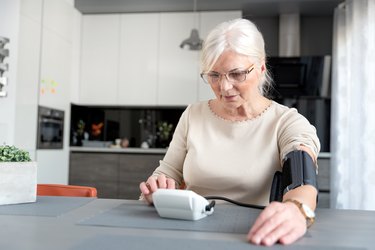
It's one of the simplest tests you can have at the doctor's office and take at home yourself. But there's a knack to correctly using a blood pressure cuff or, as it's known medically, a sphygmomanometer.
"Depending on whether or not you have been diagnosed with high blood pressure, known as hypertension, you may be advised to check your blood pressure more often than if you have normal blood pressure," says Thomas F. Boyden, MD, medical director of preventive cardiology at Spectrum Health in Grand Rapids, Michigan.
Video of the Day
Video of the Day
"For those individuals who have high blood pressure and take medications, we typically ask for a few blood pressure readings over the course of a week and to average those blood pressures to make sure that they are at goal," says Dr. Boyden
This helps you track the effectiveness of your treatment and also encourages you to stay in control of your blood pressure by making you more aware of the day-to-day readings. It can also cut your health care costs by reducing the number of doctor's visits that you have to make, according to the Mayo Clinic.
For people who have higher blood pressure due to the nervousness that results from visiting the doctor's office, known as white coat hypertension, taking your own blood pressure at home can result in more accurate readings.
Choosing a Blood Pressure Monitor
One of the most important points when selecting a blood pressure monitor to use at home is to get the right size for your arm, according to the Cleveland Clinic, so use a tape measure to get the circumference of your arm before you go shopping.
Small is for an arm circumference of 8 1/2 to 10 inches, average is for 10 1/2 to 13 inches and large is for 13 1/2 to 17 inches. For reliability, choose an arm monitor rather than a wrist cuff, and make sure it's automatic. Also ask your doctor for brand recommendations.
Measuring Blood Pressure at Home
To get accurate results when using a blood pressure cuff at home, "you should measure your blood pressure twice a day — morning and late afternoon — at about the same times every day," says Ami Beniaminovitz, MD, a board-certified cardiologist with Manhattan Cardiology in New York City.
"For best results, sit comfortably with both feet on the floor for at least two minutes before taking a measurement. When you measure your blood pressure, rest your arm on a table so the blood pressure cuff is at about the same height as your heart," says Dr. Beniaminovitz.
Not positioning yourself properly can actually result in a reading that's 10 millimeters of mercury higher than your true blood pressure, which for some people can be enough to swing from normal to elevated, according to the American Heart Association (AHA). Other mistakes, says AHA, are taking a measurement if you have a full bladder, any talking while you're taking your measurement and placing the cuff over clothing. Any misstep can add at least a few points to the reading.
Although modern blood pressure monitors are simple to use, the AHA recommends reviewing your monitor's instructions with your doctor before you begin taking them on your own to ensure the best results. Also, bring your monitor with you to office visits at least once a year to check its accuracy.
As a reminder, blood pressure is considered normal if it's less than 120 millimeters of mercury systolic (the first or top number) and less than 80 millimeters of mercury diastolic (the second or bottom number). It is considered elevated if it's 120-129 systolic and less than 80 diastolic.
Stage 1 hypertension is a reading of 130-139 millimeters of mercury systolic or 80-89 diastolic; stage 2 hypertension is 140 or higher systolic or 90 mm or higher diastolic. A hypertensive emergency would be a reading higher than 180 systolic and/or 120 diastolic and would require immediate medical attention, according to the American Heart Association.
- Mayo Clinic: “Get the Most out of Home Blood Pressure Monitoring”
- Thomas F. Boyden, MD, medical director, preventive cardiology, Spectrum Health, Grand Rapids, Michigan
- Cleveland Clinic: “Buying a Home Blood Pressure Monitor? 6 Things You Need to Know”
- Ami Beniaminovitz, MD, board-certified cardiologist, Manhattan Cardiology, New York City
- American Heart Association: “Monitoring Your Blood Pressure at Home”
- American Heart Association: “Knowledge Gaps in Getting Accurate Blood Pressure Reading”
Is this an emergency? If you are experiencing serious medical symptoms, please see the National Library of Medicine’s list of signs you need emergency medical attention or call 911.